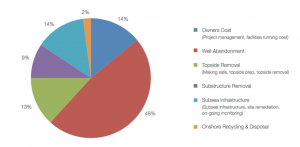
A recent Energy Voice article covered a Scottish Parliament reception where Edward Mountain, Conservative MSP for the Highlands and Islands commented on onshore decommissioning: “We have an opportunity and frankly we need to grasp it.”
Once again this left me questioning the rhetoric around decommissioning and where all this onshore decommissioning activity is going to come from. Where is the business case that supports the large number of ports claiming decommissioning as a significant opportunity?
As reported in the OGA’s June 2017 Cost Report, onshore decommissioning activities are 2% of the overall total spend. The percentage breakdown of decommissioning spend is shown in this extract from the report.
The OGA report also sets a target of a total decommissioning spend of £40 billion over the next 30 years. If it is assumed that the spend is linear, that would equate to £27 million per annum spend on onshore decommissioning. Spread that expenditure over the ports that are vying for decommissioning business – Aberdeen, Arnish, Cromarty, Dales Voe, Dundee, Fife, Kishorn, Lerwick, Lyness, Montrose, Nigg, Peterhead, Rosyth and Wick, not to mention Humberside, Tyneside and Teeside, and come up with a business case which supports Edward Mountain’s “grasp the opportunity” claim.
Of course onshore decommissioning will provide jobs and we should be fighting hard to keep those jobs in the UK/Scotland. But the exaggerated claims of some kind of missed bounty are hugely misleading.
As a taxpayer, the largest stakeholder in decommissioning, could I ask the Scottish Government, BEIS and/or the OGA to demonstrate a business case that supports multiple investment in ports throughout the country. Rather than multiple ports should we not be following the Norwegian example of investing in two or three strategic sites?
Tom Baxter is a senior lecturer in chemical engineering at Aberdeen University
Recommended for you

